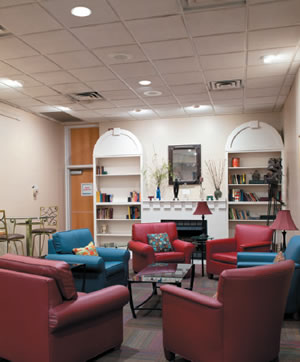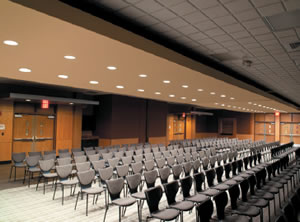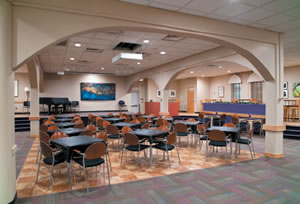Bright Lights, Big Data
From LEDs to fluorescents to precision controls, the future of lighting looks bright.

PHOTOS PROPERTY OF CREE, INC. USED BY COLLEGE PLANNING & MANAGEMENT WITH PERMISSION.
Ever since the advent of Humphry Davy’s first electric light, we have been looking for more efficient ways to illuminate our interiors. From incandescent to halogen, halide to LED, T12 fluorescents to T8 and CFLs, the choices seem endless. Throw in sophisticated controls and the ability to couple data gathering with lighting and the options just got richer. Where is college lighting now and where will it be in five years? CP&M shines a light on the answer.
LED
Discovered at the turn of the last century, light-emitting diodes (LED) remained, until recently, an expensive novelty. Today they are the cutting edge of lighting technology. They use considerably less energy than other forms of illumination, last much longer, instantly turn on and off, pair well with control systems and don’t contain any troubling mercury.
They also cost much more than other light options… or they used to. “The price of LEDs continues to come down,” says Todd Peterson, director of engineering, Seesmart, Inc., a part of Revolution Lighting Technologies, who estimates that the return on investment (ROI) ranges from six to 18 months. “Pasadena City College reports saving $3,000 a day in electricity because of their LEDs.”
Peterson also points to other inarguable benefits of LEDs. “They don’t fail like a filament bulb. LEDs get dimmer over time, but at three years you may have 70 percent of your original light. They don’t flicker like fluorescents and they put out a clean light that’s great to read and do art by.”
LEDs are also directional, meaning that they put out light in in one direction and don’t need a reflector to bounce light back to the desired location.
Maureen Moran, principal, MCLA Architectural Lighting Design, based in Washington, DC, recently finished the University of Baltimore’s John and Frances Angelos Law Center, incorporating LED in 95 percent of the entire space. “The space has a lot of open atriums and corridors to encourage interaction between students and faculty,” says Moran. “That allows us to borrow light from the outdoors, which means we can use less wattage. It’s a more efficient use of fixtures.”
As LEDs are dimmable, they work well with controls that sense daylight. It is that innate dimability that makes LEDs financially feasible. “The ballast that allows fluorescents to dim bumps up the cost, making them comparable to LEDs,” explains Moran.
LEDs and organic LEDs continue to gain market share and influence architecture. “You can do a lot with this technology,” says Moran, who predicts curved sheets or vertical planes of light embedded into walls and ceilings. There is one caveat, however. “Electricians and contractors may not be familiar with the technology, making it harder to install,” cautions Moran. She is also wary of the sheer volume of manufacturers jumping on the LED bandwagon. “Check out companies and warranties thoroughly.”

An All-LED Upgrade for Efficiency
Appalachian State University (ASU) in Boone, NC, is setting an example in energy efficiency, and being a good steward of student fees, with a move to an all-LED lighting solution in its Plemmons Student Union.
“ASU is absolutely committed to being a model of sustainability to the state by reducing our dependency on fossil fuel energy,” says Dave Robertson, director of Student Programs and the Plemmons Student Union at ASU.
“We installed the first LEDs on campus here in the student union, and helping set that standard was a big motivation for what we’re doing — along with saving money.”
The process of moving to more energyefficient lighting in the student union began in 2005, but Robertson wasn’t then yet sold on LED technology. Over time though, he was won over — a matter of becoming convinced that the color temperatures were right and the price was competitive. He’s now fully convinced, and the student union is being transitioned in increments to all LED lighting.
Robertson was taking a long-term view when he made the decision to go with an LED lighting solution. The student union’s only source of income is student fees, and he says he feels a real obligation to spend that money wisely.
“As much as we can, every year, we invest some of that money in making this building more energy efficient,” he says. “So we take a little money out of one budget year in order to save big time over the life of the building. “Meanwhile, we’re reducing our carbon footprint.”
Robertson says the university’s energy manager is watching the project with interest, and is aware of how happy the student union staff is with the LED fixtures.
Source: Cree, Inc. (www.cree.com)
Fluorescent
With LEDs gaining momentum, is there still a place for fluorescent lights?
“Most definitely,” says Chris Bailey, IES director, Lighting Solutions Center, Hubbell Lighting, Inc. “Their cost remains low while their efficiency remains high.”
Even though LEDs make up 23 percent of Hubbell Lighting’s total volume, with the promise of doubling every year, Bailey recognizes that fluorescents are still relevant. “If you are putting a whole new facility up or are a progressive client, then LEDs make perfect sense,” he says. “But if there are fluorescents with dimming ballasts already installed you can get 3,000 lumens of light for $1 to $2 a lamp. The same amount of lumens in a LED tube runs $30 to $45 a lamp.”
“Realistically, it’s going to take a long time for fluorescents to reach the bottom of the opportunity bucket,” Bailey insists.
The National Electrical Manufacturers Association (NEMA) supports his theory. In a report put out in May 2013 they state, “T5 and T8 linear fluorescent lamp indexes surged upward 6.3 and 15.7 percent on a year-over-year basis respectively during the first quarter.” The report continues with bad news for T12 technology. “Not surprisingly, the index for T12 lamp shipments continued to diminish, posting a decrease of 38.9 percent.”

THE FUTURE’S SO BRIGHT. Commercial LED lighting offers an unprecedented opportunity to save energy, maintenance and cooling costs and is a natural fit for cutting-edge renovation, new construction projects or easy retrofits. ENERGY STAR-qualified commercial products use at least 75 percent less energy and last 35 times longer than incandescent lighting. Plus, qualifi ed LED lighting produces virtually no heat and provides optimal light color for any environment.
Control
No matter what light source is chosen, controlling it remains paramount to savings, safety and satisfaction. “Wireless controls are a really exciting innovation for colleges and universities,” reports Brandon Marken, vice president of sales, Everlast Lighting. “Schools can save a lot of money if they use them.” As an example he points to Michigan State University. The school recently replaced fixtures in their Wharton Center parking garage. When the garage is vacant the lights run at 40 percent of power. Motion detectors bring the lights up to full capacity when someone is in the space. The Wharton Center estimates annual savings of over $52,000 a year because of this technology.
Controls can also be used to collect information, effectively bringing Big Data to your lighting fixtures. “Things that a university can do with this are amazing,” says Antony Corrie, vice president, Harvard Engineering Americas. “You can monitor temperature, carbon monoxide, set up a WiFi network. You can even rig your outdoor light fixture to become an electric vehicle charging station and turn it into a profit center.”
The light fixtures can even read RFIDs or smartphones, allowing retailers to push marketing materials to consumers. But college students aren’t consumers. “Yes, ‘Minority Report’ technology is out there but we haven’t had any call to create a ‘Big Brother’ lighting scheme,” says Corrie. Bailey agrees. “Our job is to provide beautiful light that enhances architecture and consumes the least amount of energy,” he says.
If it’s the cost of new lighting that’s keeping schools back, Corrie points to another emerging trend. “Private Finance Initiatives (PFI) are private organizations that fund all or part of a new installation,” he reports. “Then they take a part of the ROI. It’s a creative means of getting systems employed.”
This article originally appeared in the College Planning & Management November 2013 issue of Spaces4Learning.